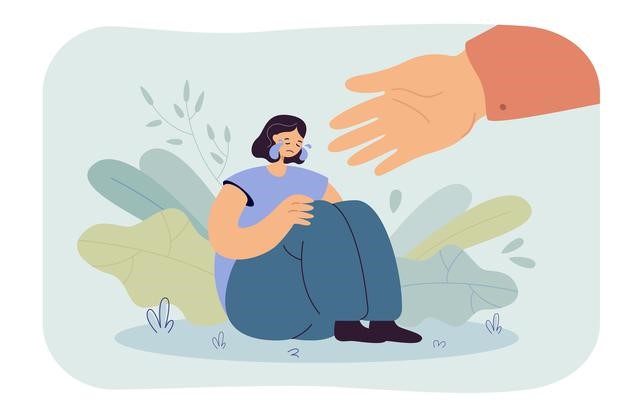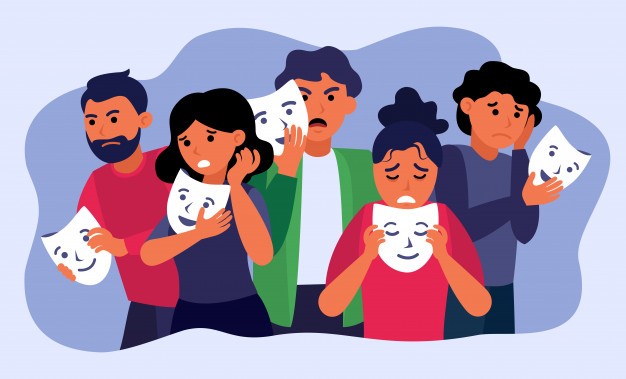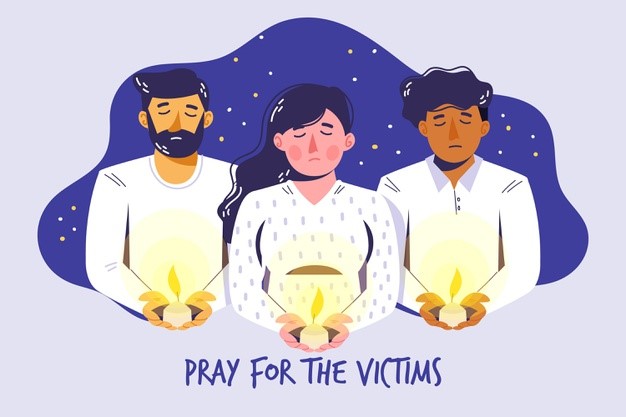7+ Types of Grief That We All Experience

Grief! An emotion that we often associate with death. Which itself is a big life challenge and event to process your emotions through. But is death the only kind of loss we experience throughout our lives? Certainly not!
We do experience grief for other things in our life but we are barely aware of where this feeling is coming from. Today we shall try and understand all types of grief so that we can acknowledge the one we are experiencing and work through it instead of struggling with it. So let us take an initiative for our mental wellness and for those around us and learn about different forms of grief.
7+ Types of Grief That we Experience
1. Non-death Loss
A loss of something close that holds a great value in an individual’s life at a physical, psychological, or spiritual level is a non-death loss. This involves loss like developing chronic illness, abuse, loss of home or property, trauma, separation, empty nest, life transition, rehabilitation, or estrangement.
These events leave a negative impact on an individual’s emotional well-being and require help to process through the same. If you have read about Maslow’s need hierarchy, you can think of non-death loss as a loss of those needs. Which in turn impacts an individual’s life profoundly.
2. Secondary Loss
After experiencing a primary or big loss, an individual might experience a subsequent loss. This subsequent loss is kicked off by the devastating big loss in their life. It can be in the form of loss of income, relationship, identity, love, hope, home, support system, health, or security after the first big loss of the death of a loved one.
Basically, a person loses a loved one and the concrete things that they had to offer in their lives. The secondary loss doesn’t need to be experienced right after the first one, it may unfold with time. A person identifies, assesses, and gets to know about the secondary loss over time.

3. Ambiguous Loss
The term Ambiguous loss was first coined by Pauline Boss. She examined ambiguous loss as a part of her research. I refer to ambiguous loss as grieving the living. Herein the person is still there in your life but their physical or psychological absence makes you feel distant from them.
Usually, people with long-distance terms, dementia, Alzheimer’s, or divorce experience this form of loss. The change or unavailability of someone to be by your side makes you feel like you have lost someone, which in turn leads to the feeling of grief.
4. Cumulative Loss
A pile of loss that an individual experiences. It comes up when an individual undergoes several losses in a relatively less amount of time, they are frequent and in succession. Unlike secondary loss where the second loss is experienced over time, cumulative loss is back to back, without much time to identify the primary or secondary loss.
This overload of multiple losses in such a short period often ends up taking a heavy toll on an individual’s life. An example of cumulative loss would be a flood victim who loses his family, home, income, property, and loved ones one after the other. With pain being piled upon pain, resilience building and therapy are the best course of action to work through this loss.
5. Nonfinite Loss
Ever since the day we learn to process our thoughts and feelings, we unconsciously also learn to imagine. While we are sitting, eating, praying, listening to someone, we are also imagining ourselves and our lives. This imagining of living a particular style of life and having certain hopes from it starts at a relatively young age. And we all start living our lives in the direction of accomplishing these imaginations and give reality to our hopes.
However, when these childhood imaginations and hope are not fulfilled or go unmet, an individual experiences a sense of loss- infinite loss. Not getting what one has been wanting from earlier days of life, results in the feeling of loss and further initiates struggles to achieve it.
This dissonance needs to be addressed and dealt with for a healthy living of an individual with peace of mind and a sense of satisfaction. An example of non-finite grief is: Having dreamt of a job and a house to achieve by the age of 25, and not being able to get it, may trigger non-finite grief.
6. Anticipatory Grief
Just like anticipatory anxiety where you get anxious before coming in contact with anxiety-provoking stimuli, anticipatory grief is marked with grieving before the potential loss takes place. An individual may start thinking of grief and life afterward, Usually, it involves the emotions of regular grief like-sadness, anger, depression, and more but that is not it.
The reason why anticipatory grief is a matter of concern is that it has certain complicated emotions which can lead to exhaustion and burnout. To me, it is the most unhealthy form of grief as you put yourself through the same pain of loss twice, once by thinking about it, and the second time when the loss takes place in real life.
Although the study supports that symptoms of grief are reduced after anticipatory grief, more research needs to be conducted in this direction. Taking care of yourself and talking about it, is the best way to walk through anticipatory grief
7. Disenfranchised Grief
Understanding the concept of disenfranchised grief is important from both a feeler and supporter point of view. It helps you stop seeking validation from others to grieve on one hand, and stops you from asking others to hold their grief on the other.
Generally, when society and others around us tell us not to express our grief, feel it, or acknowledge it, it is referred to as disenfranchised grief. The reason behind this might be coming from a good place but ultimately it ends up doing no good. It is like someone asking you to minimize or stuff your grief within (which of course is unhealthy).
Disenfranchised grief may get triggered by phrases like you shouldn’t be grieving, there is nothing to grief about, don’t grief. It makes an individual feel like they lack social validation and support to feel grief and work through it. As a feeler, you should allow yourself to feel the loss or join a social support circle, and as a supporter avoid asking others to not grief, rather be there for them.

8. Other Forms of Grief
Apart from the common types of grief that we have discussed above, there are some more forms of grief that an individual can experience. This includes:
Complicated grief: When an individual keeps swinging between the different stages of grief, which disturbs their daily life functioning they are likely to experience complicated grief. Wherein they feel stuck and are not aware of any way out of it. An individual often requires help from professionals to work through complicated grief.
Chronic grief: When the grief continues to last for a longer period than expected it is classified as chronic grief. Herein, an individual does not seem to be moving forward in their life after the episode of grief has passed. Immediate help from a professional is suggested here, to avoid any further complications.
Delayed grief: Often an individual denies the pain and reality behind the loss. As a result of which he won’t display the signs of grief for a long period. Not accepting and working through grief can lead to a pile of complicated feelings within an individual. To deal with the same social support system is definitely required.
Distorted grief: When an individual runs out of ways to deal with grief healthily, they might hop on the unhealthy practices. This may involve reactions like extreme anger, hostility towards self and others, odd or destructive behavior. Before these destructive patterns divert towards self connecting with a therapist is recommended.
Prolonged grief: This type of grief is quite similar to chronic grief wherein an individual experiences intense grief that hampers their daily life functioning. The long-term experience of grief makes it difficult for an individual to move forward in their lives.
Exaggerated grief: Intensification of grief reaction which worsens over time is referred to as exaggerated grief. It might take the form of nightmares, extreme fears, or even trigger serious mental health conditions in an individual. Seeking help from a psychologist can help here.
Masked grief: When the signs of grief interfere with the daily life functioning of an individual without him being aware of the same, he might be experiencing masked grief.
Usually, a person might attribute the reasons to physical conditions or maladaptive practices. The signs of grief are not addressed as the cause behind their current conditions. Journaling your thoughts and emotions can help here to find out the true cause behind your current life situations.

Traumatic grief: When the loss of someone is accompanied by a traumatic or dreadful life event it is referred to as traumatic grief. Traumatic grief tends to take a heavy toll on an individual’s overall well-being causing severe distress. That is why having a strong support system and connecting with a mental health professional is suggested to deal with it.
Inhibited grief: The kind of grief that is felt inwards with no outward manifestation is called inhibited grief. By piling up these emotions inwards an individual may later complain of somatic issues. That is why it is recommended to feel the loss to work healthily.
Abbreviated grief: When the grief is experienced for a relatively shorter amount of time it is called abbreviated grief. Space or role being filled by someone else, less attachment with the deceived, or quick acceptance of grief are some of the underlying reasons behind this type of grief.
Absent grief: I refer to this grief as stone grief! Herein, an individual just like a stone shows no expression, signs, or actions of experiencing grief. He might act as nothing has happened. It is suggested that denial of the reality might be underlying this form of grief. Here it is important to note them and be there for them.
Collective grief: When the grief is felt by a group of people or community it is called collective grief. Like loss to a natural disaster, of a community idol, or other mass casualties. Herein the grief is experienced by not one but many. However, how they process through it will differ widely.

Webinar To Understand and Deal with Grief
Take home message:
Everyone experiences different types of grief throughout their lifespan. Grief, along with being an inevitable part of human life, is also a personal and highly individual experience. The way you process through your grief is your individual journey and it is certainly not a One size fits all concept. So take your time to work through your grief and don’t compare your journey with others, as there is no normal timeline of grieving.
Have you ever experienced any of these types of grief in your life that you were not even aware of? Share your story with us on our Write A Story page. You never know, you might just inspire someone!
If you need professional help to process the type of grief you are experiencing, book your first therapist appointment here.
More power to you!




















